The secret’s out: transitional bathroom vanities are in. This year marks the first year that transitional vanities have proven to be more popular – and featured in more homes – than either modern or traditional vanities. Modern styles were most prominent in the mid-2000’s, and more traditional styles reigned supreme before that, but vanity buyers have raised their voices in unison and made it clear: the future is versatile. The future is comfortable. The future is transitional.
The “transitional” style is a really effective way to bring your bathroom design into the 21st century by updating and refining your vanity cabinets, without being “too modern.”
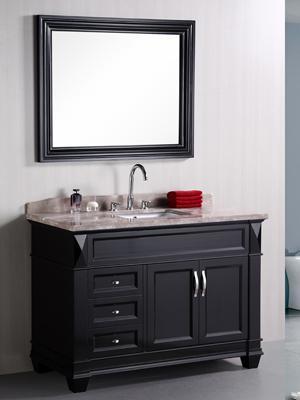
OK… but what does that mean? I mean, really?
What Is Transitional Design, Anyway?
Well first, you can check out our transitional collection here to get a basic visual idea.
Checked out some vanities? Great! Now let’s move on and break down just what “transitional” means.
“Transitional design,” much like the vanities that fall under its categorical umbrella, favors a perfect balance of form and function: it simply refers to a style that toes the line between “traditional” and “modern.”
Traditional
So, for example, take this vanity:
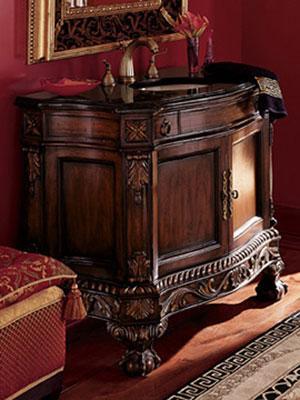
This is our 47” Ball and Claw Single-Sink Bathroom Vanity. I think we can all agree, this is certainly “traditional” in its design. Looking at this picture, you can practically smell the cherry wood. The rich natural lumber hues and wood grains shine through, especially in sunlight. The countertop is shaped and polished stone – black granite, in fact. The faucet and handle hardware is very ornate as well. And look at those adornments – this vanity has claw feet and floral patterns engraved into its side panels, for crying out loud! It’s majestic! Antique vanities have these features in common: they tend to be made from rich natural hardwoods and stone, they feature sweeping shapes and intricate engravings, and classic brushed hardware. Traditional vanities are beautiful and convey a sense of luxury and royalty. They are also quite heavy, rather bulky, and – less affordable than other vanity designs, to put it kindly.
Here are a few other “traditional” examples:
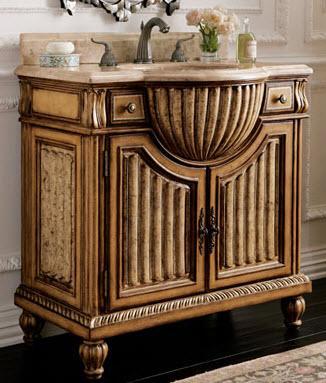
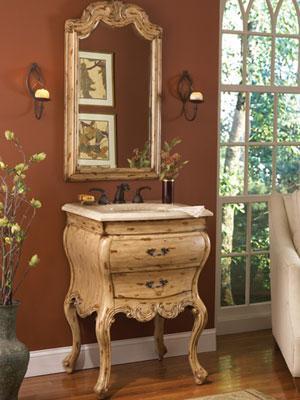
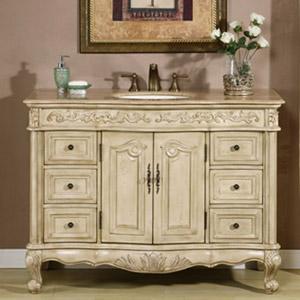
And of course, you can see a lot more antique models here.
Modern
Now, on the opposite end of the spectrum, we have this sleek cabinet:

This is our 39.5” Lynx Single Sink Bathroom Vanity, a Trade Winds exclusive! It’s a modern vanity, in every sense of the word. It’s very simple in its design, but elegant and sophisticated in its execution. Modern style is defined by an overarching “less is more” philosophy, often deeply rooted in “zen” principles and the Feng-Shui concept of flow. It’s also wall-mounted, which is a common feature for many single and even double-sink vanities in the modern purview. The vessel sink on the Lynx is also very uniquely-shaped, but still retains a calculated, sleek, geometric edge that defines its corners and creates a lot of morphic contrast with the cabinet. Even the cabinet handles are minimalist, favoring easy notches rather than decorative metal bars. Modern vanities are sleek, bold, efficient, and inescapably “cool.” They tend to be lightweight and more affordable than antique vanities, but their composition often makes them more fragile as well. Not to mention, the bare nature of these vanities means some plumbing hardware often shows through, and there may be less storage space in the slim cabinets than in other, more voluminous styles.
Here are a few other “modern” vanity models in our collection:
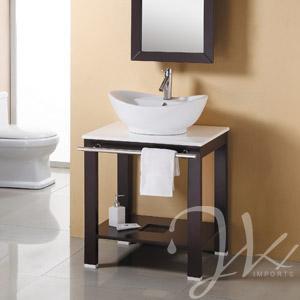
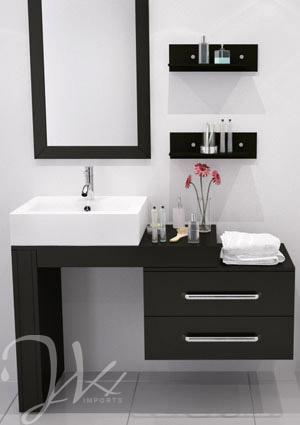
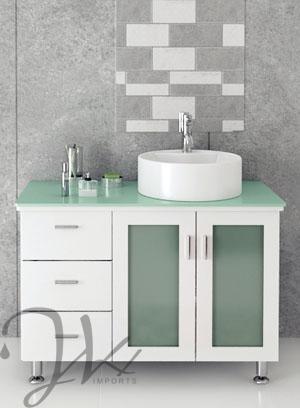
You can check out more of our sleek sinks in our modern bathroom vanity collection.
And… Transitional
“Transitional” design is somewhere between the two.
For example, here is our 30” Helena Single Vanity.
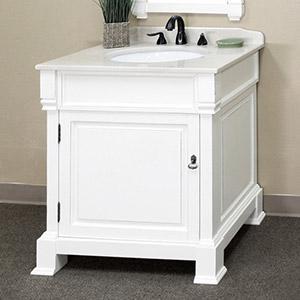
You’ll notice, first of all, that while this vanity has some engraved faces and a few minor decorative flourishes – the decorations don’t pop out as much as with antique or traditional vanities. Everything is more subdued and calm, stylistically, but without becoming so subdued that the vanity lacks decoration at all, as with many modern cabinets. The high color contrast is very modern, as are the proportions of the vanity, and the general muted appearance of the cabinet. However, the vanity exudes a more classic charm, embellished further by the brushed metal hardware. It’s a great cross between contemporary and traditional styles.
Or how about this one? This is our 36.6” Thetford Transitional Vanity.

What do you notice about this cabinet? First, you might notice that the vanity is notably devoid of any architectural embellishments and engraved edges. It’s very sleek and aerodynamic in its aesthetic, like many modern vanities. However, it has a smooth, gentle curve out and along the cabinet drawers that exudes a more glamorous, ritzy, and classic look. The door knobs on the vanity cabinet are large and obvious, almost gaudy, and they punctuate the modern espresso finish with a clash of tradition to outweigh the zen simplicity. The faucet hardware, too, is very traditional, with an antique finish and some embellished decorative accents along the handles and stem.
Here is yet another example: Our 30.5” Myrtle Beach Single-Sink Vanity.
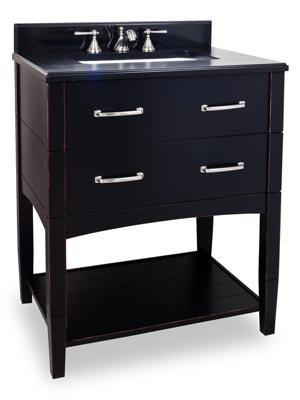
Another example of modern sensibilities clashing with traditional design, this transitional bathroom vanity is reminiscent of the type of sink you’d expect in an old craftsman home somewhere along the shores of the eastern seaboard. This vanity is more “Maine” than “Manhattan,” but it nevertheless features some sleek, hip design elements that land it squarely in “transitional” territory: a simplified and ‘flattened’ style, with small and unassuming hardware, and a simple, neutral color scheme, countered with a more embellished faucet system and some antique signatures like the arch motif and the flatboard bottom.
And of course, you can click this link to view the rest of our transitional collection.
So, what can we gather from all this? Well, to define “transitional bathroom vanities” best, we’d simply say: “Transitional design is literally a style that toes the line between modern and antique, to varying degrees.”
That’s Pretty Vague.
Yup!
But that’s the nature of evolving design. Traditional vanities were all the rage while the “modern” style we know so well today was just picking up steam, and now, transitional vanities are evolving to meet a new and massive market: vanities for people who don’t like either extreme. People who don’t want vanities that look like they came out of an old French castle, nor vanities that look like they’d belong in a space station before they’d belong in the typical bathroom.
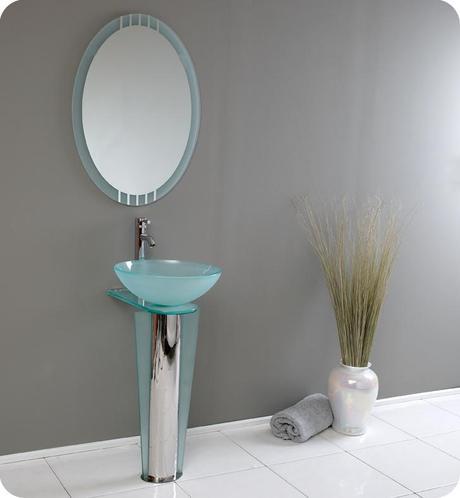
Style in Transition: Alright, I Get What “Transitional Vanities” Are; But Why Should I Choose Them?
Because you are a unique individual.
No one is completely in one camp or the other; you need to figure out where on the style spectrum your own unique preferences lie. Are you 70% modern and 30% traditional? Or 70% traditional and 30% modern? Maybe you really love modern cabinet architecture, but prefer antique hardware and accoutrements? Or how about the opposite? Transitional vanities give you the opportunity to create a bathroom that is as unique in its voice and style as you are. People aren’t so interested in “Keeping Up With The Joneses” anymore, people are more interested in developing their own personal “brand.”
In many ways, transitional vanities are timeless.
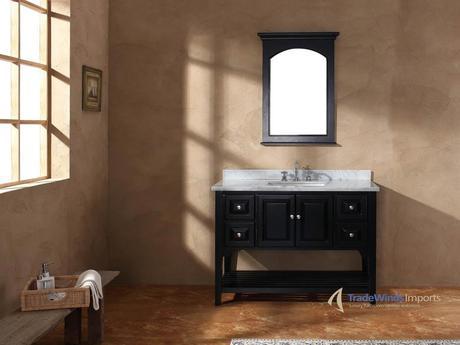
Transitional vanities, by avoiding extremes and mixing traditional and modern elements effortlessly, make a lasting impression that will always be comfortable and cool.
Transitional cabinets are optimally functional and will make it easy to store your toiletries and towels in your bathroom, saving you trips to the linen closet. They are practical and easy to use. And they have a versatile, varied design that accentuates the finest characteristics of both the “modern” and “traditional” design worlds.
Marvel as sleek, angular lines and high-contrast framing, akin to modern design, blends strikingly with rich natural wood grain hues and stone countertops, commonly seen in antique designs. This creates a thrilling juxtaposition that is visually impressive and alluring, while not being so ostentatious that it sticks out like a sore thumb.
Transitional Vanities – Because Your Self Expression is Important!
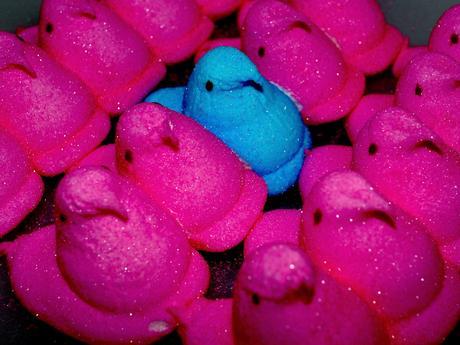
We are unique individuals with our own tastes, styles, preferences, and voices. We yearn to express ourselves in many ways, not the least of which is the manner in which we decorate our bathrooms. Bathroom vanity design is too rich, too compelling, too broad and creative and innovative to be confined to a binary system of “modern” and “antique.” Design exists on a spectrum that is as complex and sophisticated as we are. Find where you are on the spectrum, and meet the perfect cabinet for your needs!
Check out our awesome collection of Transitional Bathroom Vanities today!
Call us at 1-888-900-0477 or contact us directly today to learn more about our great transitional cabinets.
Want to read something less sales-y and more fun? Check out our favorite blog posts this month.
About This Post
Mike Bowman is a freelance writer who helps TradeWindsImports.com with their content and marketing needs. He’s not sure how to categorize the vanity in his own home, but he’s pretty sure it’s “old.” Mike loves design, philosophy, and the philosophy of design. When he’s not writing or studying tons of analytic data, he’s sharing cool images on Pinterest.
